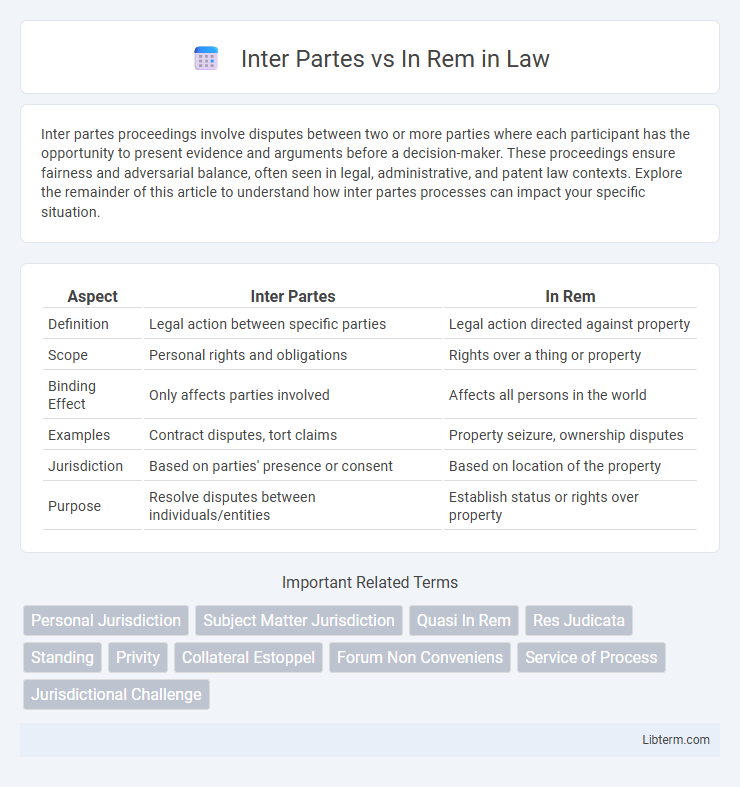Inter partes proceedings involve disputes between two or more parties where each participant has the opportunity to present evidence and arguments before a decision-maker. These proceedings ensure fairness and adversarial balance, often seen in legal, administrative, and patent law contexts. Explore the remainder of this article to understand how inter partes processes can impact your specific situation.
Table of Comparison
| Aspect | Inter Partes | In Rem |
|---|---|---|
| Definition | Legal action between specific parties | Legal action directed against property |
| Scope | Personal rights and obligations | Rights over a thing or property |
| Binding Effect | Only affects parties involved | Affects all persons in the world |
| Examples | Contract disputes, tort claims | Property seizure, ownership disputes |
| Jurisdiction | Based on parties' presence or consent | Based on location of the property |
| Purpose | Resolve disputes between individuals/entities | Establish status or rights over property |
Introduction to Inter Partes and In Rem
Inter Partes refers to legal proceedings or rights involving specific parties directly affected by the issue, typically requiring active participation from those parties. In Rem, on the other hand, pertains to jurisdiction over property or status against the world at large, independent of individual ownership claims. Understanding these distinctions is crucial for determining the scope and enforceability of legal actions in intellectual property, maritime law, and real estate contexts.
Legal Definitions of Inter Partes and In Rem
Inter Partes refers to legal proceedings or rights that involve specific parties, where judgments affect only those individuals directly involved in the case. In Rem denotes legal actions or rights concerning property or status, granting judgments that apply universally to the world at large, rather than specific persons. Understanding these distinctions is crucial for determining jurisdiction, the scope of enforcement, and the nature of legal remedies in civil and property law.
Historical Background of Legal Doctrines
Inter Partes and In Rem legal doctrines have distinct historical roots shaping jurisdiction and property rights. Inter Partes originated in common law to resolve disputes between specific parties, emphasizing personal obligations and relationships. In Rem, deriving from Roman law, focused on rights or interests against the world, primarily concerning property status and control.
Scope of Application: Inter Partes vs In Rem
Inter Partes proceedings involve disputes between specific parties with rights directly affected by the matter, limiting the scope of application to those engaged in the litigation. In Rem proceedings target the property or status itself, binding the whole world by adjudicating rights against the object, regardless of parties present. The fundamental distinction lies in Inter Partes focusing on personal rights and In Rem establishing rights in rem that have general applicability.
Jurisdictional Differences Explained
Inter Partes jurisdiction involves legal proceedings directly between specific parties, where a court's decision binds only those involved in the case. In contrast, In Rem jurisdiction focuses on rights over a particular property or status, allowing courts to assert authority over the property itself, affecting all potential claimants. The key jurisdictional difference lies in Inter Partes targeting personal claims between parties, while In Rem governs property-related disputes with broader binding effects.
Procedural Distinctions in Practice
Inter Partes proceedings involve disputes between specific parties where each has a direct interest in the outcome, often requiring formal pleadings, discovery, and the opportunity for both sides to present evidence and cross-examine witnesses. In contrast, In Rem actions concern the status or control of a particular property or right, focusing on the property itself rather than individual claims, and typically proceed without needing to identify or involve all possible interested parties. Procedurally, Inter Partes cases are adversarial and party-driven, while In Rem cases prioritize jurisdiction over the property, leading to distinct rules on notification, jurisdiction, and evidence presentation.
Key Examples and Case Studies
Inter Partes proceedings involve disputes between specific parties, commonly seen in patent oppositions such as the United States Patent and Trademark Office's Inter Partes Review process, exemplified by cases like *Oil States Energy Services, LLC v. Greene's Energy Group, LLC*. In Rem actions address rights against a particular property or status, famously illustrated in maritime law with cases like *The Amiable Nancy*, where courts adjudicate property interests directly rather than personal disputes. These distinctions highlight procedural differences critical in intellectual property and property law, influencing litigation strategy and judicial outcomes.
Advantages and Limitations of Each Approach
Inter Partes proceedings offer a focused resolution between specific parties, enabling tailored outcomes and often quicker dispute settlement, but their effects are limited to those involved and do not establish broader rights against third parties. In Rem actions provide a binding decision against a particular asset or status, offering comprehensive enforcement that protects public or general interests, yet they tend to be more complex and time-consuming with wider procedural requirements. Choosing between Inter Partes and In Rem depends on the desired scope of enforceability and the need for efficiency versus comprehensive legal certainty.
Impact on Parties and Third Parties
Inter Partes proceedings directly impact the involved parties by allowing them to present evidence and argue their rights, creating a binding resolution specifically between those parties. In Rem actions affect the property or status itself, binding all third parties regardless of their participation, thereby providing broader legal certainty over the subject matter. This distinction influences how rights are enforced and challenges are raised, with Inter Partes offering personalized adjudication and In Rem delivering universal effect over the asset or status.
Conclusion: Choosing the Appropriate Legal Remedy
Selecting the appropriate legal remedy depends on the nature of the dispute and the desired enforcement scope; inter partes remedies address rights and obligations between specific parties, providing targeted relief. In rem remedies assert claims against a particular property or status, creating binding effects upon the world at large. Legal practitioners must evaluate case specifics, jurisdictional nuances, and enforcement goals to determine whether an inter partes or in rem approach best serves client interests.
Inter Partes Infographic

 libterm.com
libterm.com